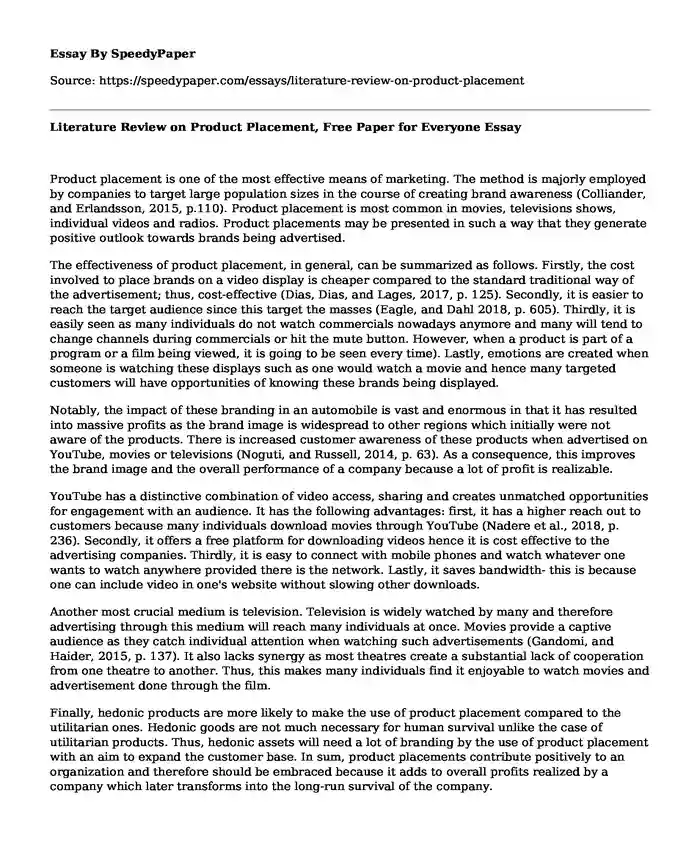
| Type of paper: | Literature review |
| Categories: | Marketing Literature review |
| Pages: | 3 |
| Wordcount: | 720 words |
Product placement is one of the most effective means of marketing. The method is majorly employed by companies to target large population sizes in the course of creating brand awareness (Colliander, and Erlandsson, 2015, p.110). Product placement is most common in movies, televisions shows, individual videos and radios. Product placements may be presented in such a way that they generate positive outlook towards brands being advertised.
The effectiveness of product placement, in general, can be summarized as follows. Firstly, the cost involved to place brands on a video display is cheaper compared to the standard traditional way of the advertisement; thus, cost-effective (Dias, Dias, and Lages, 2017, p. 125). Secondly, it is easier to reach the target audience since this target the masses (Eagle, and Dahl 2018, p. 605). Thirdly, it is easily seen as many individuals do not watch commercials nowadays anymore and many will tend to change channels during commercials or hit the mute button. However, when a product is part of a program or a film being viewed, it is going to be seen every time). Lastly, emotions are created when someone is watching these displays such as one would watch a movie and hence many targeted customers will have opportunities of knowing these brands being displayed.
Notably, the impact of these branding in an automobile is vast and enormous in that it has resulted into massive profits as the brand image is widespread to other regions which initially were not aware of the products. There is increased customer awareness of these products when advertised on YouTube, movies or televisions (Noguti, and Russell, 2014, p. 63). As a consequence, this improves the brand image and the overall performance of a company because a lot of profit is realizable.
YouTube has a distinctive combination of video access, sharing and creates unmatched opportunities for engagement with an audience. It has the following advantages: first, it has a higher reach out to customers because many individuals download movies through YouTube (Nadere et al., 2018, p. 236). Secondly, it offers a free platform for downloading videos hence it is cost effective to the advertising companies. Thirdly, it is easy to connect with mobile phones and watch whatever one wants to watch anywhere provided there is the network. Lastly, it saves bandwidth- this is because one can include video in one's website without slowing other downloads.
Another most crucial medium is television. Television is widely watched by many and therefore advertising through this medium will reach many individuals at once. Movies provide a captive audience as they catch individual attention when watching such advertisements (Gandomi, and Haider, 2015, p. 137). It also lacks synergy as most theatres create a substantial lack of cooperation from one theatre to another. Thus, this makes many individuals find it enjoyable to watch movies and advertisement done through the film.
Finally, hedonic products are more likely to make the use of product placement compared to the utilitarian ones. Hedonic goods are not much necessary for human survival unlike the case of utilitarian products. Thus, hedonic assets will need a lot of branding by the use of product placement with an aim to expand the customer base. In sum, product placements contribute positively to an organization and therefore should be embraced because it adds to overall profits realized by a company which later transforms into the long-run survival of the company.
References list
Colliander, J. and Erlandsson, S., 2015. The blog and the bountiful: Exploring the effects of disguised product placement on blogs that are revealed by a third party. Journal of Marketing Communications, 21(2), pp.110-124.
Dias, J.A., Dias, J.G. and Lages, C., 2017. Can negative characters in soap operas be positive for product placement?. Journal of Business Research, 71, pp.125-132.
Eagle, L. and Dahl, S., 2018. Product placement in old and new media: examining the evidence for concern. Journal of Business Ethics, 147(3), pp.605-618.
Gandomi, A. and Haider, M., 2015. Beyond the hype: Big data concepts, methods, and analytics. International Journal of Information Management, 35(2), pp.137-144.
Naderer, B., Matthes, J., Marquart, F. and Mayrhofer, M., 2018. Children's attitudinal and behavioral reactions to product placements: Investigating the role of placement frequency, placement integration, and parental mediation. International Journal of Advertising, 37(2), pp.236-255.
Noguti, V. and Russell, C.A., 2014. Normative influences on product placement effects: Alcohol brands in television series and the influence of presumed influence. Journal of Advertising, 43(1), pp.46-62.
Cite this page
Literature Review on Product Placement, Free Paper for Everyone. (2022, Apr 18). Retrieved from https://speedypaper.com/essays/literature-review-on-product-placement
Request Removal
If you are the original author of this essay and no longer wish to have it published on the SpeedyPaper website, please click below to request its removal:
- Personal Experience Essay: Never Forget Your Childhood Dreams
- Free Essay: New Harvest Coffee Roasters Brews Up Fresh Business
- Essay Example on the Challenges in the Food Industry
- Free Essay Sample on Water Carriers and Pipelines
- Essay Sample for Everyone: Affordable Care Act (ACA) and Force of Change
- Book Review of The Conquest of the Incas by John Hemming, Free Essay
- Essay Example. Discussion of the Field Day Flier
Popular categories




